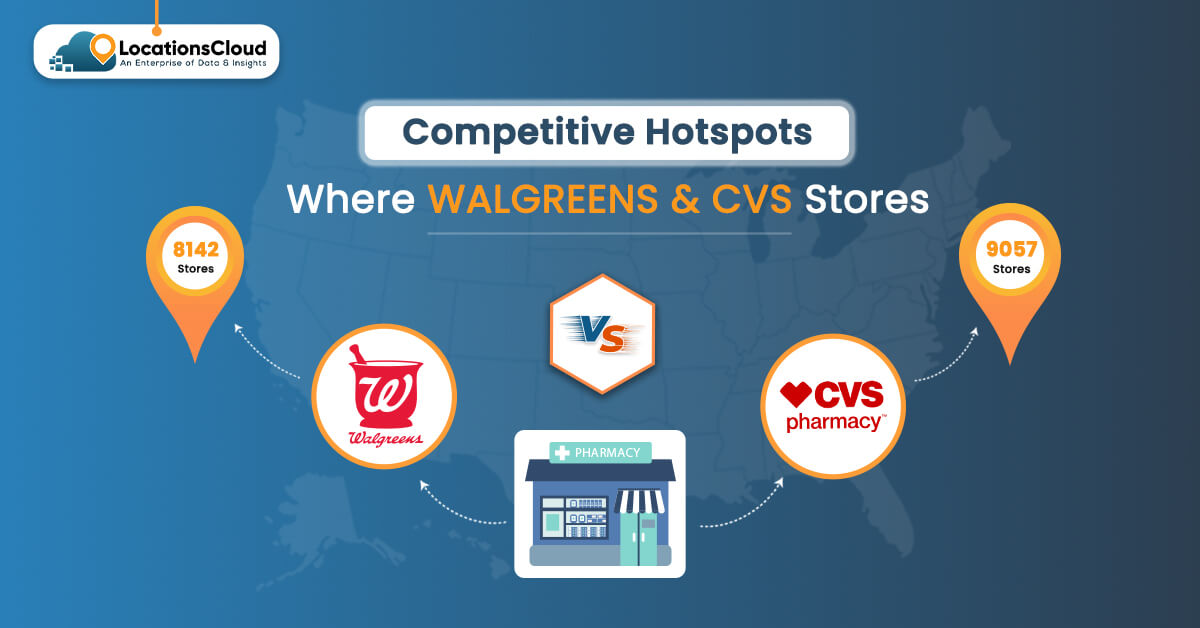
Walgreens and CVS are both giant players in the US pharmacy and retail market. Both have multiple stores across the US states and cities, and compete for various pharmacy product categories. Walgreens and CVS provide prescription drugs, which are the first line of defence for acute medical issues. It is also surprising for many customers who often see these stores located in each other’s vicinity (walking distances). This overlapping of their stores is one of the boldest competitive strategies and a very calculated one that both players have mastered.
- CVS claims that 85% of US citizens reside within five miles of a CVS store. With over 9K+ stores across the USA, CVS is a kind of neighborhood store for anyone living in the USA.
- Again, Walgreens is not behind. Over 75% of US citizens live in the radius of 5 miles of a Walgreens store.
Both strategic decisions and market dynamics have compelled these two to stay close to each other (often across the street) where their stores overlap in location. As both need high-traffic areas for ideal customer footfall, their location intelligence analysis often shortlists the same type of locations that are easily accessible by pharmacy product/service seekers.
When competitors are located near each other, price and service are the only differentiators. Despite its long-standing presence, Walgreens has faced challenges in recent years. The company has been closing more stores than CVS and has struggled with its push into primary care. Like other retail pharmacies, Walgreens has grappled with falling reimbursement rates for prescription drugs, inflation, softer consumer spending, theft, and competition from Amazon and grocery stores.
This research analysis will help new pharmacy retail entrants understand the current competition and identify growth opportunities or detect market saturation.
Quick Competitive Snapshot: Walgreens Vs. CVS
| Comparison Parameters | Walgreens | CVS |
| Number of Stores in the USA | 8142 Locations | 9057 locations |
| Head quartered | Deerfield, Illinois | Woonsocket, Rhode Island |
| CEO | Tim Wentworth | David Joyner |
| 5 States with the highest locations | 1. Florida 2. Texas 3. Illinois 4. California 5. New York | 1. California 2. Florida 3. Texas 4. New York 5. Pennsylvania |
| 5 Cities with the highest locations | 1. Chicago 2. Houston 3. New York 4. Miami 5. Las Vegas | 1. Houston 2. Miami 3. New York 4. Chicago 5. Dallas |
| States Without Any Store Location | ● American Samoa ● Guam ● Northern Mariana Islands | ● Puerto Rico ● American Samoa ● Guam ● U.S. Virgin Islands ● Northern Mariana Islands |
| Loyalty Program name | myWalgreens | ExtraCare |
Key Findings
● CVS runs more locations across the country, with over 9,000 stores, while Walgreens operates a little over 8,000.
● These retailers have built strong networks, with CVS placing 85% of Americans within five miles of one of their stores, while Walgreens covers 75% within the same distance
● Both stores cluster in states with large populations, such as Florida, Texas, California, Illinois, New York, and Pennsylvania.
● In Florida, Walgreens leads with 788 stores, which make up 9.85% of its total. CVS holds its largest count in California, where it has 1,067 stores representing 11.78% of its overall number.
● American Samoa, Guam, and the Northern Mariana Islands see little activity from either company.
● Both retailers share many of their best-performing cities, including Houston, Chicago, New York, and Miami, in their top five spots.
Walgreens
Walgreens is an integrated pharmacy and retail giant with over 150 years of heritage. A trusted name in retail pharmacy, Walgreens has over 12500 locations across the USA, Latin America, and Europe. Walgreens’ services include pharmacy, health plans, and health systems across primary, multi-specialty, and urgent care healthcare settings.
In fiscal 2024, the U.S. Retail Pharmacy did $115.8 billion in sales, and 77% of Walgreens’ sales came from pharmacy. Walgreens’ U.S. Retail Pharmacy includes retail drugstores, health and wellness services, and home delivery pharmacy services, too. Walgreens has pharmacy retail offerings in 50 states, operating over 8000 stores and employing over 89K providers.
Top 5 States With the Highest Number of Walgreens Stores
Florida (788 Stores)
Florida leads with 788 Walgreens locations. It accounts for 9.85% of all Walgreens stores in the United States. This number highlights Florida’s massive population, a large elderly community needing more pharmacy care, and Walgreens’ clear focus on serving this state.
Texas (728 Stores)
Texas takes the second spot with 728 Walgreens locations, making up 9.1% of the chain’s U.S. stores. The state’s size and its spread-out population create a strong market, and Walgreens has targeted it as key to growing its business.
Illinois (536 Stores)
Illinois has 536 Walgreens locations, accounting for 6.7% of the company’s store count in the United States. A big factor in this is Chicago, where Walgreens has its largest urban cluster with 116 stores.
California (493 Stores)
California holds 493 Walgreens outlets, making up 6.16% of the nationwide total. Even though California has the most people, it comes in fourth place for Walgreens stores. This hints at tougher competition from CVS and other chains in the area.
New York (440 Stores)
New York State has 440 Walgreens stores, accounting for 5.5% of Walgreens’ total U.S. locations. The high population density, particularly in New York City with its 74 stores, makes this a key market despite challenges like high real estate costs.
Top 5 Cities With the Highest Number of Walgreens Stores
Chicago
Chicago in Illinois, has 116 Walgreens stores. It leads all U.S. cities in the number of Walgreens locations. This strong presence shows Walgreens’ local history, as Chicago is not only the company’s hometown but also tied to its beginnings.
Houston
Houston in Texas has 97 Walgreens locations. This shows how well the company has expanded into this big and spread-out city home to a mix of neighborhoods and different healthcare needs.
New York
New York City has 74 Walgreens stores. High real estate prices and tough competition have not stopped Walgreens from having a solid foothold in the biggest city in the United States.
Miami
Miami in Florida has 52 Walgreens locations. This highlights Walgreens’ broad coverage across Florida and its focus on busy areas filled with lots of people and plenty of tourists.
Las Vegas
Las Vegas, Nevada, has 49 Walgreens locations. This reflects how much the company values both the local community and the huge number of tourists visiting every year.
CVS Pharmacy
CVS Health leads as one of the top pharmacy chains in the United States operating more than 9000 stores. In 2024, it earned $372.8 billion in revenue. The company has grown from being just a pharmacy chain to providing full healthcare services. Its purchase of health insurer Aetna gave it an advantage over rivals, including Walgreens.
CVS operates more stores than Walgreens, keeping a bigger footprint nationwide. Similar to Walgreens, CVS deals with issues like reduced reimbursement rates, inflation, theft, and growing competition from online stores. Still, CVS manages to stay strong by relying on a diverse business strategy that combines retail, insurance, and pharmacy benefit management
Top 5 States With the Highest Number of CVS Pharmacy Stores
California (1067 stores)
California has 1067 CVS Pharmacy stores. That is 11.78% of total CVS Pharmacy stores in the USA. This large number shows how much CVS has focused on California. Being the most crowded state, California plays a big part in CVS’s plans, where it stays ahead of Walgreens by a large margin.
Florida (801 stores)
Florida has 801 CVS Pharmacy stores. This strong presence connects to the state’s big population and a lot of elderly people who need more healthcare services. The number of stores matches that demand.
Texas (768 stores)
Texas has 768 CVS stores, which is almost the same as Walgreens in the state. This similarity shows how the two chains compete head-to-head in this huge and varied market.
New York (532 stores)
CVS runs 532 stores across New York. This gives CVS a small advantage over Walgreens in this populated state with many urban areas.
Pennsylvania (454 stores)
CVS operates 454 stores in Pennsylvania. Walgreens does not include this state in its top five, showing how CVS has managed a strong foothold in the Northeast.
Top 5 Cities With the Highest Number of CVS Pharmacy Stores
Houston
Houston in Texas has 84 store locations. It is slightly fewer than Walgreens’ 97 stores. This close competition in America’s fourth-largest city highlights the strategic battle between the two chains.
Miami
Miami in Florida has 69 CVS store locations, exceeding Walgreens’ 52 stores. This advantage demonstrates CVS’s stronger position in this key metropolitan market.
New York
New York City has 60 CVS store locations, compared to Walgreens’ 74. While Walgreens has more total stores, the two chains often compete directly in high-traffic areas.
Chicago
Chicago in Illinois has 55 CVS store locations, less than half of Walgreens’ 116 stores. This disparity reflects Walgreens’ historical advantage in its hometown market.
Dallas
Dallas in Texas has 52 CVS store locations, demonstrating the chain’s strong presence in another major Texas metropolitan area.
The Strategic Overlap: A Calculated Competition
Both chains see online pharmacy services becoming more important. CVS is now the top drugstore for pharmacy shoppers, taking the lead over Walgreens.
Analyst Aditya Kaushik explains that a big reason for this is CVS owning the insurance company Aetna. He says, “Consumers are bound to shift towards the CVS stores because if they just purchased from CVS pharmacies, they can claim insurance”.
What makes the rivalry between Walgreens and CVS so interesting is how often their stores sit close to each other. You’ll often spot a Walgreens right across the street from a CVS or just a short walk away. This isn’t a coincidence. It’s a planned move that both companies use to compete with one another.
Both strategic decisions and market dynamics have compelled these two pharmacy giants to stay close to each other.
There are a few reasons behind this trend:
- Both chains require locations with high visibility and foot traffic to maximize customer access. Their location intelligence analyses often identify the same prime spots.
- The idea behind Hotelling’s Law says competitors stick close so they can grab the biggest slice of the market. It’s like ice cream sellers gathering in the middle of a beach to serve more people.
- Each chain sets up near its rival to stop the other from dominating a neighborhood or business zone.
- Consumers expect pharmacies to be easily accessible, leading both chains to target areas with high residential density and good transportation access.
Conclusion
Walgreens and CVS are household names for prescription drugs in the USA. Both pharmacy retailers have their unique identities, differentiators, and location bases across the United States. But beneath the surface of their seemingly similar business models lies a tale of strategic positioning, calculated overlap, and fierce competition for market dominance.
Both chains face similar challenges from changing consumer behaviors, online competition, and economic pressures.
For new entrants to the pharmacy retail space, understanding the strategic positioning of these two giants provides valuable insights into market opportunities and competitive challenges.
If you need store location datasets of Walgreens and CVS Stores, LocationsCloud offers them at competitive prices.


